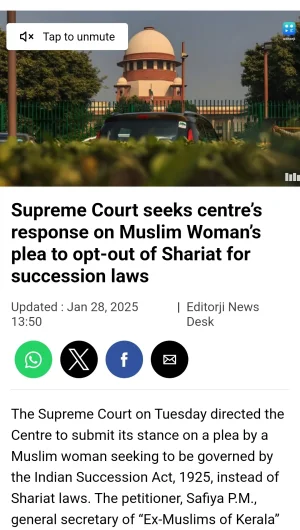- Joined
- Jul 2, 2024
- Messages
- 631
- Likes
- 1,912
Resurgent Bharat searching for its identity, but tread carefully
The name ‘India’ originates from Greek literature. During Alexander’s narrow victory on the northwestern border of the Indian subcontinent, Greek historians began documenting the lands they encountered. Although Alexander’s successors, such as Seleucus, later lost to Chandragupta Maurya, the local king, and withdrew from the region, the Greeks continued using the name derived from the Persian word ‘Hind’, which itself was a modification of ‘Sindhu’, the mighty river’s original Sanskrit name. Over time, the word ‘India’ evolved from Greek and was Latinized. The British subsequently adopted this term as the name for the region they were set to conquer.
The word Hindu similarly traces its origins to Sindhu. The Persians, unable to pronounce “S,” adapted the term Sindhu to Hindu, referring to the people of this land.
The land’s original name, however, was Bharat, rooted in ancient Indian tradition. It is believed to be derived either from King Bharata, a prominent figure in Indian mythology, or from the descendants of the composers of the Rig Veda.
When Muslim invaders first came to the region, beginning with Muhammad bin Qasim’s conquest of the Sindh area in seventh century via Iran, they referred to the land as ‘Hindustan’, based on their custom of naming territories after the dominant cultural or religious groups—Hindus in this case. Later, Afghan and Turkish rulers continued to call the region Hindustan.
When the British arrived in southern India in the 16/17th century, they preferred the term India over the Muslim designation Hindustan, firmly establishing India as the name of the region.
Today, India is no longer under foreign rule, yet it continues to use English as its dominant link language, and the name ‘India’ persists.
While India is experiencing a remarkable economic resurgence, it now has the ability to reclaim its heritage by shedding the name given by invaders and restoring its original name, Bharat.
Historically, this land of Hindus has been unified only once or twice, from Kashmir to Kanyakumari and from the Sindhu River to the Irrawaddy River in the east. According to historical accounts, Emperor Ashoka achieved such unification in the 3rd century BCE, and much later, the Mughal emperor Aurangzeb attempted it. However, Aurangzeb died of old age before fully achieving his ambitions either in the east or south.
It was the commercially minded British who consolidated India into a single administrative unit. Recognizing that the population was largely Hindu or culturally similar despite religious differences, the British unified the region for administrative and economic efficiency. Their primary interest was financial, ensuring that wealth was transferred to England. A unified governance structure, a single army, and centralized administration served these goals well.
This is how a diverse India—with its shared culture, centralized administration, and common governance—emerged as a unified entity. Remarkably, the people of India have preserved this framework, ensuring that the nation’s identity and unity remain intact.
Now the time is here that this resurgent nation reclaim its ancient heritage of ‘Bharat’
The name ‘India’ originates from Greek literature. During Alexander’s narrow victory on the northwestern border of the Indian subcontinent, Greek historians began documenting the lands they encountered. Although Alexander’s successors, such as Seleucus, later lost to Chandragupta Maurya, the local king, and withdrew from the region, the Greeks continued using the name derived from the Persian word ‘Hind’, which itself was a modification of ‘Sindhu’, the mighty river’s original Sanskrit name. Over time, the word ‘India’ evolved from Greek and was Latinized. The British subsequently adopted this term as the name for the region they were set to conquer.
The word Hindu similarly traces its origins to Sindhu. The Persians, unable to pronounce “S,” adapted the term Sindhu to Hindu, referring to the people of this land.
The land’s original name, however, was Bharat, rooted in ancient Indian tradition. It is believed to be derived either from King Bharata, a prominent figure in Indian mythology, or from the descendants of the composers of the Rig Veda.
When Muslim invaders first came to the region, beginning with Muhammad bin Qasim’s conquest of the Sindh area in seventh century via Iran, they referred to the land as ‘Hindustan’, based on their custom of naming territories after the dominant cultural or religious groups—Hindus in this case. Later, Afghan and Turkish rulers continued to call the region Hindustan.
When the British arrived in southern India in the 16/17th century, they preferred the term India over the Muslim designation Hindustan, firmly establishing India as the name of the region.
Today, India is no longer under foreign rule, yet it continues to use English as its dominant link language, and the name ‘India’ persists.
While India is experiencing a remarkable economic resurgence, it now has the ability to reclaim its heritage by shedding the name given by invaders and restoring its original name, Bharat.
Historically, this land of Hindus has been unified only once or twice, from Kashmir to Kanyakumari and from the Sindhu River to the Irrawaddy River in the east. According to historical accounts, Emperor Ashoka achieved such unification in the 3rd century BCE, and much later, the Mughal emperor Aurangzeb attempted it. However, Aurangzeb died of old age before fully achieving his ambitions either in the east or south.
It was the commercially minded British who consolidated India into a single administrative unit. Recognizing that the population was largely Hindu or culturally similar despite religious differences, the British unified the region for administrative and economic efficiency. Their primary interest was financial, ensuring that wealth was transferred to England. A unified governance structure, a single army, and centralized administration served these goals well.
This is how a diverse India—with its shared culture, centralized administration, and common governance—emerged as a unified entity. Remarkably, the people of India have preserved this framework, ensuring that the nation’s identity and unity remain intact.
Now the time is here that this resurgent nation reclaim its ancient heritage of ‘Bharat’



